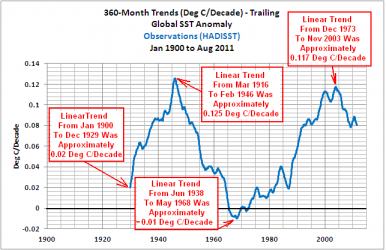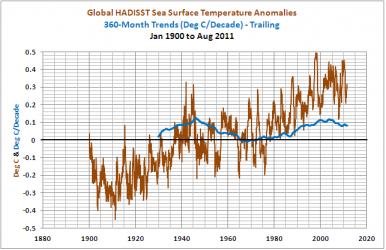Old Rocks
Diamond Member
Dishonest CON$ always use the data from the defective ARGO floats, long after the defective floats were discovered and the problem corrected, that misread the depth and were recording temperatures at depths much deeper than their sensors recorded giving cooler temperatures.Ummmm, sure it did. Here is a graph from the AGW cultists you quote with diarhetic regularity...Note how there is all this heat in the oceans (that Trenberth can't seem to find, it's hiding down there somewhere in violation of all physical laws we know of, but it's down there) and the other graph is from ARGO. You'll notice the actual empirical data shows a slight decline in the oceans temp. Not some fanciful "I can't find the missing energy in the oceans because my damned dog at it" bullshit.
Here is a chart from the journal Nature of the real ARGO data from floats reading the correct depth.
CGD 2010 Profiles in Science: Dr. Kevin Trenberth
Trenberth, K.E. and J.T. Fasullo. 2010: Global Change: The ocean is warming, isn't it? Nature, 465, 304-304, doi:10.1038/465304a.

Figure 2: High resolution figure
A reappraisal of the messy data on upper-ocean heat content for 19932008 provides clear evidence for warming. But differences among various analyses and inconsistencies with other indicators merit attention.
Global atmospheric temperatures at Earth's surface are often taken as an indicator of global warming. Yet the atmosphere is battered by all sorts of natural variability associated with weather phenomena. More robust indicators of a warming planet come from evidence of increasing ocean heat content and associated sea-level rise. Yet observing systems that capitalize on these insights are in their infancy. On page 334 of this issue, a step forward is reported by Lyman et al.1 they find a robust warming of the global upper ocean to be present in the data, in spite of considerable uncertainties arising from the observations themselves.
Figure caption: Changing heat content of the global ocean, with respect to the mean of 1993 to 2008.

Here's what NOAA has to say about your little graphs.
http://www.cpc.ncep.noaa.gov/products/analysis_monitoring/enso_update/gsstanim.gif
Dumb ass, that is current Enso conditions.







